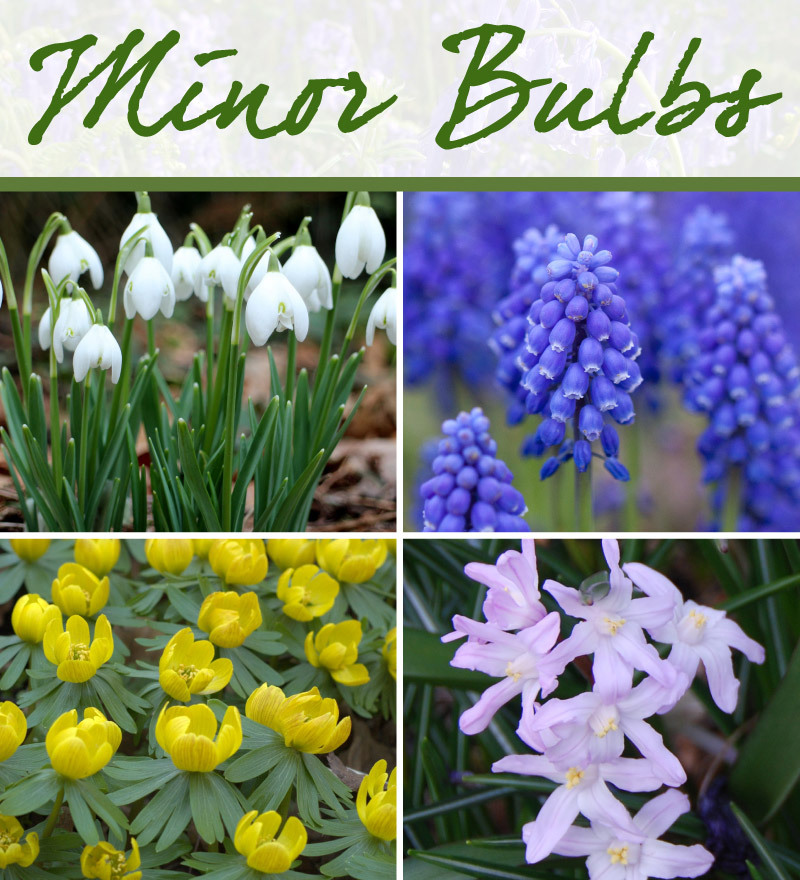We Know That Timing Is Everything
Bulb of the Week: Minor Bulbs
Gardeners everywhere strive for perfect timing so there is always something blooming during the growing season. Those who are in-the-know use “minor” bulbs to extend bloom time while adding color and texture to the landscape.
What is a minor bulb? These are the pint-sized, easy-care plants, including Grape Hyacinths (Muscari) and Snowdrops (Galanthus nivalis), that often play supporting roles in the garden. Due to their short stature, minor bulbs grow well under trees and shrubs, in garden borders, and in mixtures of taller bulb plants in beds and containers. They are also ideal for naturalizing the landscape.
Just because they are called “minor” doesn’t mean these lovelies can’t assume a starring role, especially when planted en masse or in random clusters throughout the landscape. A drift of naturalized Snowdrops, Winter Aconite, or Snow Crocus will provide eye-catching early season interest. In fact, these three plants are often the first to “wake up” in your garden, and are often seen blooming even if the snow has not yet melted.
Miniature Daffodils are also considered minor bulbs and make a lovely addition to the garden. Tete-a-Tete, a dwarf yellow; Jetfire, a compact yellow with a petite orange cup; and Canaliculatus, a bicolored variety, are three examples. Botanical Mixture is an assortment of numerous dwarf Daffodil species. Speciosa Tulips, small dwarf growing varieties, are also considered minor bulbs.
Minor bulbs can also add fragrance to your garden. Grape Hyacinths have a light perfume that is an added bonus beyond their lovely clusters of white, purple, and blue deer resistant flowers.
Don’t stop there! Scilla produces tiny spikes of bell-shaped azure or white flowers that raise their heads above the plant’s grassy leaves. Glory of the Snow (Chinodoxa) blooms in pale pink and white and blue, and Camassia sends up spikes of star-shaped flowers in blue, purple, or white. Allium Moly, a charming yellow flower, adds excitement to the garden from May through June. You may also try Wood Hyacinth (Hyachinthoides) Hispanica Mixture.
If you want a natural look, scatter your bulbs and plant them where they land. For a more “manicured” look, add planned groupings of minor bulbs to your woodland garden or rock garden.
Many of these tiny wonders are easy to plant, since you won’t have to dig deep into the soil. The rule of thumb is to plant a bulb three times as deep as the bulb’s diameter.
Do remember to add an appropriate fertilizer, like Bulb-tone, and a layer of mulch to keep your bulbs protected over the winter. Minor bulbs can also be layered over such bulbs as large cupped Daffodils or large flowering Tulips. The larger bulbs will be planted about 8 inches deep and covered with approximately 4 inches of soil, and then the minor bulbs can be added right on top.
If your yard is full of deciduous trees and tends to get shady later in the spring and summer, remember that many early-blooming bulbs will be at their best long before the trees leaf out, so they will have plenty of sunshine when they need it most.
Reminder: If you decide to naturalize minor bulbs in your lawn, you will need to wait until the plants’ leaves die back before you cut the grass. Your bulbs need their leaves to produce the energy they need to survive during the growing season and while the plants are dormant. Allowing your bulbs to reabsorb the nutrients from their leaves will ensure a repeat performance next spring.
We are ready to answer your questions about the best ways to use minor bulbs, and we look forward to seeing you soon. Happy Planting!

